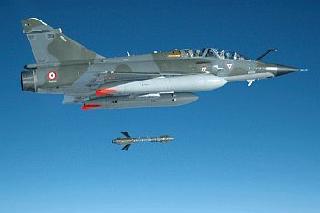
An unrelated photo of an IAF jet dropping a precision-guided missile
NEW DELHI (PTI): By the end of next year, Indian fighter planes could be equipped with indigenously-developed 'glide bombs', which will be guided to their targets for precision attacks.
The first-of-its-kind bomb in the country, being developed by the DRDO, will boost India's strike capabilities as targets can be hit even beyond the range of a fighter aircraft.
The DRDO is working on developing glide capabilities on the existing bombs of various payloads including 100 kgs, 250 kgs and 500 kgs.
"We are developing glide bombs which can be directed towards their intended targets using guidance mechanisms after being dropped from aircraft of the IAF," outgoing DRDO chief V K Saraswat told PTI in an interview.
"Such a capability will allow the IAF pilots to drop the bombs at their intended targets from stand-off distances as the glide capabilities will help in enhancing the range of the bombs," he said.
The DRDO has already carried out two trials of such bombs successfully and plans to hold more trials this year for proving the capabilities of the ammunition.
"By the end of the next year, we want to complete all the development trials of the glide bombs before offering it to the IAF," he said.
The outgoing DRDO chief said the organisation is also in the process of developing an anti-radiation missile, which will multiply the strike capabilities of the armed forces by destroying the enemy's advance warning system.
Such missiles can be mounted on Sukhoi fighter planes Su-30 MKI.
These missiles can detect a radar by tracking its electro-magnetic radiation and pulses generated and these would be independent of the radar wavelength and be able to destroy it.
Such missiles, currently in use of some major powers like the US, can detect and attack a radar antenna or transmitter with minimal aircrew input.
The proportional guidance system that homes in on enemy radar emissions has a fixed antenna and seeker head in the missile's nose.
The ARMs are used by the US Air Force and they move at the speed of over Mach 2, propelled by a smokeless and solid-propellant rocket motor.
The US Air Force introduced High Speed Anti-Radiation Missiles (HARM) on the F-4G Wild Weasel and later on specialised F-16s equipped with the HARM Targeting System (HTS).
Listing the successful test-firing of the over 5,000 km range Agni-5 missile as the "crowning glory" of his tenure as DRDO chief, Saraswat said more lethal versions of the missile would be developed.
He said the DRDO was working on producing a variant of the missile with Multiple Independently Targeted Re-entry Vehicle (MIRV) warheads. This MIRV capability would make the missile capable of carrying multiple warheads to destroy several targets in one go.
Terming it as a "force multiplier", he said, "I will be able to do force multiplication with this... where I was using four missiles, I may use only one missile."
He said a few more tests of the missile would be done before it is ready for induction into the armed forces.
On the joint venture programmes to develop Medium-range Surface to Air Missile (MR-SAM) and Long-range SAM (LR-SAM) with Israel, he said the programme has been delayed by two years due to some technological problems.
India and Israel have formed a joint venture under which the IAF and the Navy would get these missile systems.
 Previous Article
Previous Article Next Article
Next Article









The Indian Air Force, in its flight trials evaluation report submitted before the Defence Ministry l..
view articleAn insight into the Medium Multi-Role Combat Aircraft competition...
view articleSky enthusiasts can now spot the International Space Station (ISS) commanded by Indian-American astr..
view article